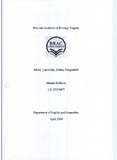| dc.contributor.advisor | Manzoor, Sohana | |
| dc.contributor.author | Siddique, Monira | |
| dc.date.accessioned | 2010-09-20T05:49:52Z | |
| dc.date.available | 2010-09-20T05:49:52Z | |
| dc.date.copyright | 2009 | |
| dc.date.issued | 2009-04 | |
| dc.identifier.other | ID 05303007 | |
| dc.identifier.uri | http://hdl.handle.net/10361/140 | |
| dc.description | This thesis is submitted in a partial fulfillment of the requirements for the degree of Bachelor of Arts in English, 2009. | |
| dc.description | Cataloged from PDF version of thesis. | |
| dc.description | Includes bibliographical references (page 69-70). | |
| dc.description.abstract | For the people of all ages drama has always been one of the most favorite forms of literature. Within the genre of drama, there are various forms of plays. However, it is seen that a particular form of play becomes popular in a particular period of time. For example, revenge tragedy was very popular among the audience of very late sixteenth century to the mid seventeenth century. Within this short period, which covers three different ages- Elizabethan, Jacobean and Caroline period, revenge tragedy changes a lot. In my dissertation paper by examining the plays of Thomas Kyd's play The Spanish Tragedy, William Shakespeare's Hamlet, and John Webster's The Duchess of Malfi, I have made an attempt to show how these changes took place and the gradual development in English drama. | en_US |
| dc.description.statementofresponsibility | Monira Siddique | |
| dc.format.extent | 74 pages | |
| dc.language.iso | en | en_US |
| dc.publisher | BRAC University | en_US |
| dc.rights | BRAC University thesis reports are protected by copyright. They may be viewed from this source for any purpose, but reproduction or distribution in any format is prohibited without written permission. | |
| dc.subject | English and humanities | |
| dc.title | The rise and evolution of revenge tragedy | en_US |
| dc.type | Thesis | en_US |

